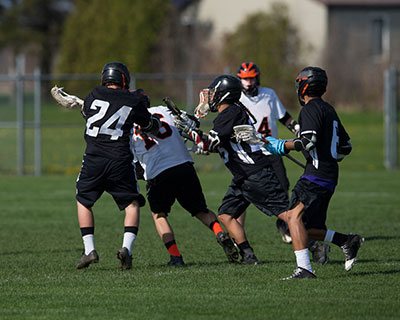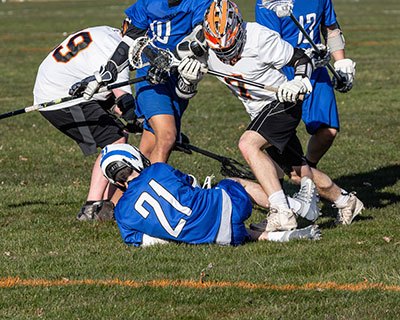Are you a lacrosse player looking to stay up-to-date on the newest rules and regulations governing interference penalties?
Look no further!
This guide provides an overview of how the interference penalty has evolved in lacrosse, as well as tips and strategies for avoiding this costly penalty.
Whether you're playing in your backyard or a competitive tournament setting, understanding the nuances of interfering with an opponent is key to staying safe and having successful seasons ahead.
More...
Take Away Key Points:
If you want to know more about interference penalties and lacrosse rules regarding this topic, refer to the guide below to find the best information, and understand the concept better.
What is an interference penalty in lacrosse?
A lacrosse interference penalty is an infraction of the rules where a player impairs the play of an opposing player. In lacrosse, it is considered an egregious offense and can result in a warning or suspension from the game depending on the severity.
At the college and professional level, an interference penalty could cause a team to be denied possession of the ball, resulting in a turnover. This can be especially impactful during pressure-packed late-game situations, making it important for players to be aware of their environment at all times and avoid any contact that would be deemed unnecessary.
Interference penalties are just one example of how lacrosse is steeped in respect for rules and opponents alike – qualities that help make this an exciting sport for everyone involved.

How can an offensive player violate the interference rules?
The lacrosse rules prohibit any player from deliberately interfering with the free movement of the opposing player unless that player has possession of the ball.
Interference compromises almost any action, preventing the opponent from pursuing the ball deliberately.
Interference includes various actions, such as an illegal screen, illegal body checking, illegal cross checking, pushing, holding, etc.
How to recognize interference in lacrosse?
Interference in lacrosse shows up in multiple ways. The crucial one is when an offending player holds or blocks the opponent who is not in the possession of the ball, thus preventing the player from assisting his team members or chasing the loose ball.
However, the interference lacrosse penalty won't occur if the opponent has possession of the ball, or is five yards within the radius of a flying ball, or a loose ball. Thus, both lacrosse players are pursuing the ball or trying to keep possession, the actions occur as a form of legal defense. But, in other circumstances, the penalty will be called upon the player violating the rules.
What happens if a player is not within five yards of a loose ball?
If the player interferes with his opponent when the other player is not within five yards of the flying or loose ball or doesn't have the ball possession, the interference penalty will be assigned to the offensive player.
Is lacrosse interference a personal or technical foul?
Lacrosse interference is a type of violation that can result in a technical foul, which is a lesser version of a personal foul. The same rule applies to youth lacrosse and NCAA men's lacrosse.
When the offensive player violates the rules, the technical foul penalty is the immediate turnover of the possession of the ball to team B. However, when a defensive player violates the rules, the punishment is a 30-second releasable penalty for the offended team and the player from the same team.
Thus, the offending defensive player can return to the field from the penalty box before the thirty-second of the running time is over if the other team has scored a goal during the penalty time.
What are examples of lacrosse interference?
Below are some of the most common examples of interference.
- The first team has the ball possession and moves towards the goal. During the attack, the opponent - a defender from the other team, makes contact with another player from the offensive team. The player doesn't have ball possession or uses illegal screening. The defender receives a thirty-second penalty for interference.
- One team uses two players to pass to each other and cut around the crease. However, before the ball leaves the offensive player's stick, the opponent - a defender from the opposing team checks the opponent's stick and prevents him from receiving the ball. Thus, the offending player will receive a thirty-second releasable penalty.
- A player from team A uses an offensive screening for his team member, who is currently in the ball possession. The first player runs toward his opponent from team B in pursuit of the second player, but without making contact. The opponent cuts around him, and the first player remains stationary merely screening him. Even though the opponent can call for interference, there won't be a foul or penalty, as the first player performed a legal offense again his opponent.

How does the referee signal the technical foul for interference?
For both the NCAA and youth lacrosse, the signal for interference is the same. The official will stand with arms crossed across his chest and an X-shaped method. He will also place his arms on his shoulders.
Similar lacrosse penalties for interference
Below you can find some of the most similar penalties to interference penalties. Some of them include: illegal procedure, warding, holding, offside, illegal offensive screening.
Illegal procedure
Illegal procedure in lacrosse includes multiple actions to slow and stop play, including touching the ball with hands, leaving the penalty box before the time is up, too many players on the field, delaying the game, failing to advance, etc.
Warding
Warding in lacrosse refers to a violation of the rules where a player uses his arms to push another player away while he possesses the ball.
Holding
Holding is a term used to explain a situation in which one player keeps another player from getting to where he is headed by using his feet, their lacrosse stick, or his arms to stop him.
Offside
Offside refers to the circumstances when there are too many offensive or defensive players on the offensive or defensive side of the field.
The rule states that there must never be more than six offensive players or seven defensive players (the goalie included) on the same offensive or defensive end of the field.
FAQs
What are the consequences of being called for interference in lacrosse?
For the offensive players, the consequence is the change of the ball possession for the opponent. On the other hand, the consequence for the defensive players is a thirty-second suspension from the play.
What are the types of interference in lacrosse?
Interference includes various types, such as illegal screening, pushing, cross checking, and holding.
What is goalie interference in lacrosse?
The goalie interference is similar to other players. Goalie interference includes preventing the player who does not possess the ball from or is further than five yards from the flying or loose ball to get to the ball. any player can commit such a rule violation, and the goalie is included as well.
Summary
If you are a lacrosse fan, it is important to know the difference between legal and illegal interference. While interference may not seem like a big deal, it can hurt the team and its performance.
Next time you are watching a game, be sure to pay attention to the players and see if they commit any fouls.

Freddy is the heart and soul of Lacrosse Runner. As a former athlete, Freddy is very passionate about Lacrosse. He keeps up with the sport’s changes and innovations and often tests the new equipment released by the leading manufacturers. Read more here
